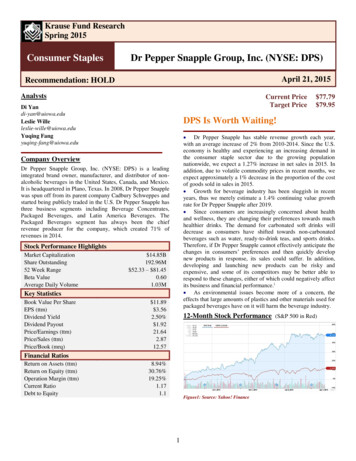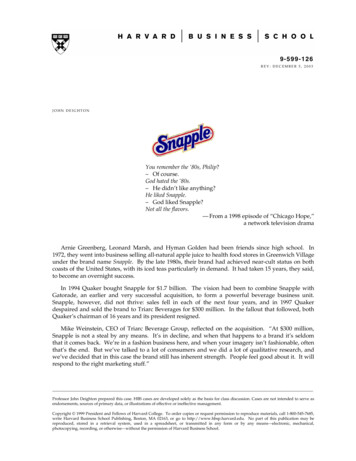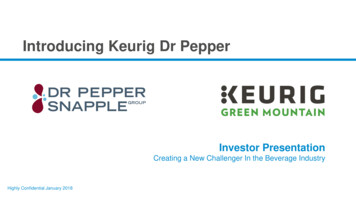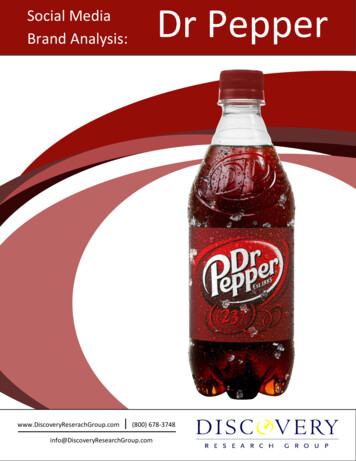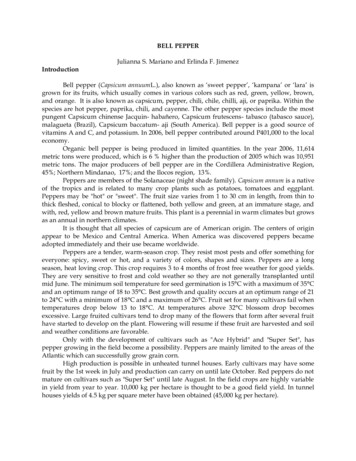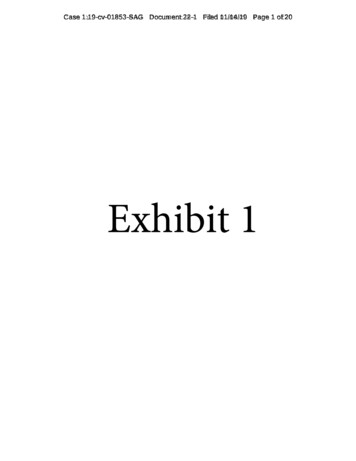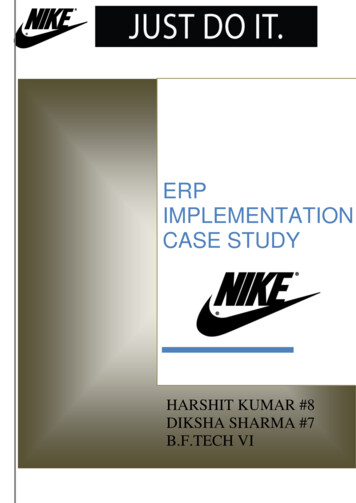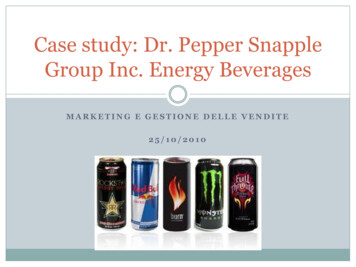
Transcription
Case study: Dr. Pepper SnappleGroup Inc. Energy BeveragesMARKETING E GESTIONE DELLE VENDITE25/10/2010
Summary The Case The Company The Energy Beverage Market in the US Marketing Plan Considerations What Shall He Do Now?
The Case In 2007, Andrew Barker is charged with assessingwhether or not a profitable market opportunity exist for anew energy beverage brand to be produced, marketed,and distributed by the company in 2008 Energy beverages are broadly defined as “drinks thatprovide a consumer with a boost of energy” The decision to explore a new energy beverage is part of acorporate business strategy, which aims at focusing onopportunities in high-growth beverage businesses. Aspart of this strategy, Dr Pepper Snapple Group, Inc. haspreviously launched the Accelerade RTD brand, a readyto-drink sport drink
Energy beverages vs. Sport drinks Energy drinks are considered functional beverages Other functional beverages include sport drinks,ready-to-drink tea, enhanced fruit drinks, soybeverages, and enhanced water Andrew Barker believes that the decision tointroduce the Accelerade RTD brand into a newbeverage market for the company (sport drinks) issimilar to the situation he faced with recommendingwhether or not Dr Pepper Snapple Group, Inc.should introduce a new branded product into theenergy beverage market
The Company Integrated brand owner, bottler, and distributor ofnonalcoholic beverages in the US, Mexico, andCanada In 2007, 89% of company net sales are generated inthe US, 4% in Canada, and 7% in Mexico and theCaribbean
The Company In the US and Canada, Dr Pepper Snapple Group,Inc. participates primarily in the flavored carbonatedsoft drink (CSD) market segment
The Company In the non-CSD market segment in the US, thecompany participates primarily in the ready-to-drinkteas, juice drinks, and mixer categories
The Company In Mexico and the Caribbean, the companyparticipates primarily in the carbonated mineralwater, flavored CSD, bottled water, and vegetablejuice categories
The Company 7 Key strengths Strong portfolio of leading consumer-preferred brands Integrated business model Strong customer relationships Attractive positioning within a large, growing, and profitablemarket Broad geographic manufacturing and distribution coverage Strong operating margins and significant, stable cash flows Experienced executive management team
The Company Business strategy: 6 Key elements Build an enhance leading brands Focus on opportunities in high-growth and high-margincategories Increase presence in high-margin channels and packages Leverage the company’s integrated business model Strengthen the company’s route-to-market throughacquisitions Improve operating efficiency
The energy beverage market in the US 4th largest nonalcoholic beverage category, aftercarbonated soft drinks, sport drinks, and bottled water,but the fastest growing one Defined by major brands, including Red Bull, MonsterEnergy, and Rockstar From 2001 to 2006, total energy beverage retail salesgrew at an average annual rate of 42.5% However, industry analysts project an average annualgrowth rate of 10.2% from 2007 to 2011, which isattributed to market maturity, increased price andpackaging competition, and the entrance of hybridenergy beverages, such as energy water, energy fruitdrinks, ready-to-drink energy teas, and energy colas
The energy beverage market in the US The energy beverage consumer Average US per capita consumption of energy beveragedrinkers increased by 14% since 2004 Gender: males Ages: 12 - 34 When: afternoon followed by morning consumption Where: at home, in the car, and at work/school Why: energy boost, mental alertness, refreshment, and taste What: energy beverage consumers limit their choice to only 1.4different brands, on average strong brand loyalty
The energy beverage market in the US Channels Convenience stores (81% in 2004 - 74% in 2006 ) andsupermarkets (11% in 2004 - 14% in 2006) are the dominantoff-premise retail channels for energy beverages Industry analysts expect continued sales erosion in theconvenience channel in the future Companies with a broad product line and an extensivedistribution network have had the greatest success in gainingshelf space in supermarkets and mass merchandisers for theirbrands Product turnover is a key consideration among conveniencestores Only brands with a limited product line that candemonstrate high turnover are stocked
The energy beverage market in the US Major competitors: Red BullNorth America Market pioneer since 1997Market leader in dollar sales and unitvolumeDecline from 82% in 2000 to 43% in2006, due to the entry of new,aggressive competitors, and brandswith lower prices 39.6 million US media expenditure in2006 and an estimated 60.9 millionin 2007
The energy beverage market in the US Major competitors: Hansen NaturalCorporation Monster Energy is its most prominentenergy drink since 2002Monster Energy sales have benefited fromrecent distributions agreements: AnheuserBusch wholesalers distribute the brand toretailers in different territories (e.g., bars,nightclubs, restaurants) in the US; PepsiCoCanada will be the exclusive masterdistributor in Canada 61,1oo US media expenditure in 2006 andan estimated 153,800 in 2007
The energy beverage market in the US Major competitors: Pepsi-Cola Division of PepsiCo, which marketsAMP Energy since 2001 and SoBeAdrenaline Rush since 2003 Both are marketed through the PepsiCola distribution system in the US No significant media expenditure in2006
The energy beverage market in the US Major competitors: Rockstar, Inc. Rockstar Energy brand was introducedin 2001 and distributed in the US andCanada by the Coca-Cola Company,except in the Pacific Northwest andNorthern California where Rockstarretains its original distributors Minimal media expenditure in 2006and 41,500 estimated for 2007
The energy beverage market in the US Major competitors: Coca-Cola The Coca-Cola Company markets the FullThrottle since 2003 and sugar-free TabEnergy brands since 2006 through itsdistribution networkThe company has been acquiring smallerenergy beverage brands and pursuinglicensing agreements to distributeindependent brands, such as RockstarFull Throttle was supported by 7.3 millionin US media expenditure in 2006 and anestimated 492,300 in 2007. The TabEnergy introduction was supported by 12.6 million US media expenditure in2006 and 20,500 are estimated for 2007
The energy beverage market in the US Major competitors: Estimated2006 Dollar Sales10%Red Bull6%43%12%13%16%Hansen Natural Corporation(Monster Energy)Pepsi-Cola (SoBe AdrenalineRush; AMP Energy)RockstarCoca-cola (Full Throttle; TabEnergy)Others (including privatelabels)
The energy beverage market in the US Major competitors: Estimated 2006 UnitVolume Market Share10%Red Bull6%30%17%Hansen NaturalCorporation (MonsterEnergy)Pepsi-Cola (SoBeAdrenaline Rush; AMPEnergy)Rockstar10%27%Coca-cola (Full Throttle;Tab Energy)Others (including privatelabels)
The energy beverage market in the US Product proliferation Line extensions (e.g., sugar-free versions, different flavors) New packaging and sizes (e.g., from the original 8.3-ounce RedBull package to 16-ounce and 24-ounce packages) Market segmentation (e.g., Tab Energy targeted at women,Full Throttle Demon sub-brand targeted at young Hispanicmen)
The energy beverage market in the US Price erosion: prices declined 30% from 2001 to2006 Larger package sizes that have a lower price per ounceThe introduction of multi-packs, which offer a lower price perounceIncreasing availability in supermarkets and massmerchandisers, including Wal-Mart, which operate with lowerretail gross margins than convenience stores
The energy beverage market in the US Average retail selling price per case for brands in major offpremise retail channels in late 2007, according to ACNielsenBrandAll off-premisechannelsSupermarkets andmass merchandisersonlyConvenience storesonlyRed Bull 68.00 63.00 70.00Monster Energy 37.00 32.00 39.00Rockstar 37.00 32.00 38.00Full Throttle 36.00 32.00 38.00AMP Energy 38.00 35.00 39.00Tab Energy 49.00 45.00 55.00Channel Average 44.00 40.00 46.00
Andrew Barker Marketing Strategy
Marketing Plan considerations Target 43 million energy drink users in the US(about 18% of the US population 12years of age or older) Males between the ages of 12 and 34 theheaviest users of energy beverages(about 70% of energy beverageconsumption) Only Tab Energy focuses on femaleconsumers
Marketing Plan considerations Product Line Regular energy beverages have an80% share of the market, sugar-freehas 20% Sizes range from 8.3 ounces (RedBull) to 24 ounces. The 16-ouncesize, representing about 50% of casesales in convenience stores, hasposted the fastest growth (150%since 2004)
Marketing Plan considerations Brand Positioning Energy boost Mental alertness Refreshment Taste
Marketing Plan considerations Marketing channel The company delivers to all types of off-premise retailerswhere energy beverages are sold Company bottlers and distributors do not serve all areas of theUS (by early 2008, 80% of the US market) Dr Pepper Snapple Group, Inc. is distributing Monster Energyin selected US territories on behalf of Hansen NaturalCorporation in 2007, but this distribution will end effectiveNovember 10, 2008
Marketing Plan considerations Manufactures suggested retail selling price andchannel margins Single-serve energy beverage drink retail prices have generallysettled at roughly 2.00 per single-serve package, regardless ofpackage sizeEstimated retail, wholesale, and manufacturer energy beveragesmargins, on a per case basis, vary within a fairly tight range Retailers typically report gross margins in the range of 40% (for supermarket)to 50% (for convenience stores), based on the manufacturer’s suggested retailpriceWholesalers (distributors and bottlers) typically report a gross margin of 30%to 36% of the price sold to retailersManufacturers typically obtain a gross margin between 60% and 66% on salesto wholesalers
Marketing Plan considerations Advertising and Promotion Except for Red Bull, brand media advertising in the energybeverage market is modest Instead, competitors rely on promotional vehicles such asbrand Web sites, events, and sponsorships In 2006, the top 5 competitors spent about 70 million foradvertising media, but the expenditures for other promotionalvehicles were 4 to 6 times higher than media expenditures
Lessons from the Sports Drink Market US Sports Drink Market In 2006, Gatorade, marketed byPepsi-Cola, was the sports drinkmarket pioneer and the perennialmarket share leader Powerade, marketed by Coca-Cola,had an 18% market share Each brand was distributedthrough its company’s extensivedistribution network that servesconvenience stores, supermarkets,mass merchandisers, and a varietyof other retailers
Lessons from the Sports Drink Market Accelerade Part of an asset purchase agreement by thecompany whereby Pacific HealthLaboratories, Inc., the original brandowner, received a royalty payment for aperiod and a royalty free license tocontinue selling Accelerade and Enduroxthrough health and nutrition outletsAccelerade was already popular with hardcore athletes given its 4:1 ratio ofcarbohydrate to protein and documentedbenefits in terms of improved endurance,enhanced rehydration, faster musclerecovery, and less postexercise muscledamage
Lessons from the Sports Drink Market Accelerade RTD Brand Launch Channels: Convenience stores, supermarkets, and massmerchandisers Target: 35 millions Americans who exercised regularly andwere concerned about being competitive Product line: 20-ounce single-serve package in 4 flavors Suggested Retail Price: 2.79, roughly twice the price of a 20ounce Gatorade single-serve package, with premium priceattributed to Accelerade’s unique point of difference: the firstprotein-enhanced sports drink Advertising and Promotion: brand Web site, podcasts, searchengine marketing, and a chat-room – “Sweat Smarter”
What shall he do now? Marketing decisions Target Product line and Positioning Choice Marketing Channel Choice Advertising and Promotion Pricing and Profitability
Target Selection All energy drink users or only heavy users? Should a select customer group be targeted, as Coca-Cola had done with Tab Energy in 2006?
Target Selection Age: 35-44 (25% users) Gender: M adult (17% users) Race and ethnicity: Caucasian (12% users)
Product Line Choice Should he introduce the brand in a single-servepackage or in a multi-pack? What package size(s) should he choose: 8-ounce, 16ounce, or 24-ounce? Should he offer both a regular and sugar-freeversion? How many flavors should be introduced: one or two?
Product Line Choice Single-serve 16-ounce Regular and sugar-free version Two flavors
Positioning Choice Energy drink positioning typically focuses on providing anenergy boost, mental alertness, refreshment, and taste formales 12 to 34 Does an opportunity exist to differentiate a new energybrand on the basis of packaging or ingredients? 16.9-ounce (5 liter) single-serve shape with a resealable screw capAugment the “energy” and “mental alertment” by increasing theamount of caffeine, herbs, and B vitamins per 8-ounce servingAdult energy drinkHead-to-head positioning against competitors
Positioning Choice Differentiation of the product on the basis ofingredients (e.g., lower carbohydrates) “Light”energy drink
Channel Choice The company supplies both off-premise and on-premiseretailers. Andrew believes that off-premise retailersrepresent the best choice. However, a decision has to bemade about which retailers to serve initially Should all off-premise retailers be served or shoulddi
Market pioneer since 1997. Market leader in dollar sales and unit volume. Decline from 82% in 2000 to 43% in 2006, due to the entry of new, aggressive competitors, and File Size: 1MBPage Count: 50
